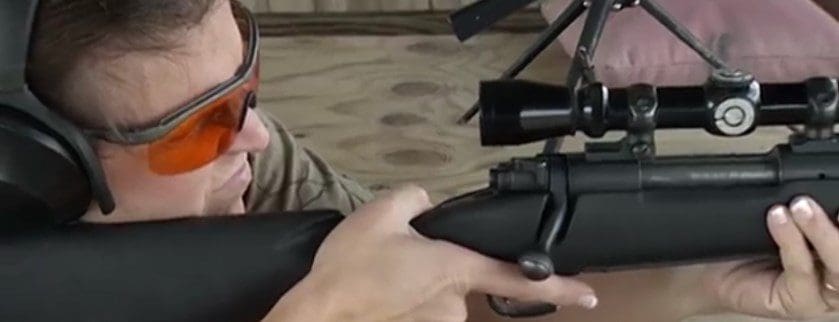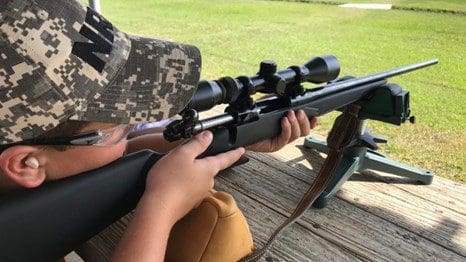Underdog Cartridge? .243 Win for the Win
Tags: NRA Women, Rifle, Range, Ammunition

Underdog Cartridge? .243 Win for the Win – NRA Women.com
Largely mislabeled as a youth or “girl’s” cartridge these days, the long-lived .243 Winchester deserves respect for the number of big-game animals it can handle.
The attempts to develop a .243 cartridge began in the 1940s, but the popular cartridge did not become a reality until after the .308 Winchester was developed in 1952. It was in 1955 when Field & Stream Editor Warren Page took the .308 Winchester and necked it down to .243 caliber, and the .243 Wildcat cartridge was born.
The .243 Win has low recoil, a flat trajectory and high velocity that transfers the energy to the target. With an average muzzle velocity of 3,300 feet per second (f.p.s.) and an average energy of 1,900 ft.-lbs. at the muzzle, the cartridge is ideal for medium game such as whitetail deer, blacktail deer, mule deer and antelope. It is also an excellent varmint cartridge, boasting excellent terminal ballistics on medium game animals out to 550 yards and accurate out to 1,000 yards.
The .243 Win quickly proved itself as an effective hunting cartridge and is still very popular today. It would be hard to find a collection of hunting rifles that did not include a rifle chambered for this cartridge. Because of its low recoil and ability to effectively drop deer and antelope, the .243 Win was the perfect cartridge for every shooter: men, women and young hunters. This cartridge was also economical for the average hunting family because those who were on a tight or fixed budget would only need to have one gun that could meet the needs of everyone in the family.

The .243 Win was one of the most respected calibers in the hunting world. The top firearms manufacturers around the world list the .243 Win as the minimum caliber size for the taking of deer, antelope and even larger game animals such as elk and moose. The cartridge is so effective that some major cities’ Special Weapons and Tactics Units (SWAT) adopted the .243 Win as their sniper rounds. With all the things going for the .243 Win, is easy to understand why at one time, it was a go-to caliber.

Unfortunately, the versatility of the .243 Win is responsible for the lack of respect among many hunters today. There are several reasons for the .243 Win falling out of favor. First, since the cartridge has low recoil, it is ideal for youth and women who are just starting to hunt. Because of this, today, many look at the .243 Win as a “kid’s” or “girl’s” gun. The cartridge has lost its place with many men who opt for newer and “sexier” calibers. In extreme cases, the idea of shooting this cartridge is insulting to some.
I recently encountered this firsthand.
A father told me he was looking for rifle shooting lessons for his sons. He shared that his boys have missed every deer they shot at last season. I asked the father what type of rifle his boys were shooting, and he told me his 12-year-old son was shooting a .270 and his 17-year-old son was shooting a .308. We agreed upon a date and time to meet at the gun range. I explained that before they shot their rifles, we would start with the basics, using my rifle. This would allow me to isolate the issues they were having.
I placed a .22 LR, bolt-action rifle on the shooting table. After going through the fundamentals, both boys showed proficiency with the .22 LR rifles. I then replaced the .22 LR rifle with a .243 Win. Using the same fundamentals, the boys shot the .243 Win effectively at 100 yards, placing all their rounds within the kill area of a whitetail deer. Next, I had the boys shoot their own rifles. Because of the recoil, neither of them could follow the fundamentals of rifle shooting when they shot their own rifles. The 12-year-old would close his eyes and tense up when he squeezed the trigger, sending his round either above or below the target. The 17-year-old did better, but only by hitting the target all over the place, with no shot grouping.
After a while, the father asked my opinion. I said, “I think you should buy them a .243 Win.” The father and older son quickly looked at each other, laughingly in unison said, “No Way!” The younger son even got teary-eyed! I then offered that my suggestion for the .243 was due to the tight grouping they each had at 100 yards, and I believe they will do just fine during deer season. I showed the father their targets and pointed out how well they did with a .243 Win, but he was not convinced. They deemed a .243 Win a “kid’s” or “girl’s” gun. They were willing to miss or even wound a deer with a “sexier” cartridge, rather than use a caliber they could shoot.

The second reason the .243 Win has fallen out of favor is that the caliber has been the target of misplaced blamed for wounded animals. While there is truth the statistics, the cartridge caliber itself should not take the fall. Rather, since the .243 Win is now regarded as a youth gun, it is the caliber that most younger hunters shoot. These younger shooters are inexperienced, which can translate to poor shot placement–regardless of the caliber.
The third reason that the .243 Win has lost respect is not because of the caliber, but because of inferior ammunition. It is a fact: Consumer demand drives the market. When adults go hunting, they demand quality ammunition that performs as expected in their “swankier” cartridge calibers. A well-placed shot quickly takes an animal down. Many of these same adults purchase the least expensive ammunition they can find when they buy ammunition for their kids who are hunting with a .243 Win. The reason many of these parents give for buying cheap ammunition for their kids, is that they are “only” shooting spikes or does.
If you find this hard to believe, visit your local sporting goods store and look at the variety of ammunition. The selection for most other calibers is very limited, very good quality ammo and you will pay premium price for it. The ammunition selection for .243 Win is broad, with prices ranging from very inexpensive to quite costly. There would not be cheap and inferior ammunition if there was not a high demand for it!
I have participated in youth hunts for more than 25 years. The gun of choice was, and still is, the .243 Win. Prior to each hunt, I was buying a popular name brand’s lower-end ammunition. It was just assumed that we would have to track a wounded deer a considerable distance after the shot. We never failed to ultimately find the deer, but the tracking was getting frustrating because we would have multiple kids on the hunt, resulting in multiple tracking scenarios.
After a couple of years of tracking wounded deer, I decided to purchase ammunition from the same manufacturer, but this time opted for the upper-end ammunition. The price of the upper-end .243 Win ammunition matched that of other “swankier” hunting cartridge calibers. The result was the same as the premium ammunition of “swankier” calibers: A well-placed shot quickly takes down an animal.
The .243 Win, with the right ammunition, is a solid caliber capable of taking any medium-sized game animal ranging from whitetail deer, blacktail deer, mule deer and antelope. Even though a .243 Win can take bigger game, a larger caliber is better suited for larger game animals such as bear, elk and moose. There is no such thing as a “one caliber fits all,” but there is a definite place for the .243 Win in your armory. So dust it off, sight it in at the range, and go hunting!
